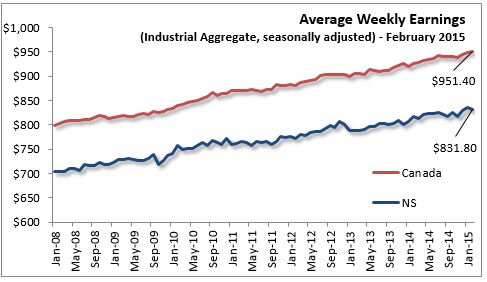To view previous releases, select one from the dropdown box:
Currently displaying information released on: June, 2017
STUDY: THE IMPACT OF AGING ON LABOUR MARKET PARTICIPATION RATES
Statistics Canada released a study last week looking at the impacts of the aging population on overall labour force participation rates in Canada using annual Labour Force Survey data from 1976 to 2016. Participation rates (the ratio of those in the labour force to the total working age population) have been declining in recent years, with the Canadian rate reaching its lowest level in 17 years in 2016, 65.7 per cent. The study notes that this overall decline has largely been the result of tw...
View complete article..
LABOUR FORCE SURVEY - MAY 2017
In Nova Scotia May 2017 (seasonally-adjusted, month-over-month and year-over-year):
- Labour force decreased 0.4% (-2,200) from April 2017 to 488,600 and increased 0.7% (+3,400) over May 2016.
- Employment remained unchanged (+200) from April 2017 at 450,200 and increased 1.1% (+5,000) over May 2016.
- Unemployment decreased 5.6% (-2,300) from April 2017 to 38,500 and decreased 3.8% (-1,500) over May 2016.
- Unemployment rate decreased...
View complete article..
LABOUR MARKET TRENDS - MAY 2017
Nova Scotia's seasonally adjusted employment increased by 200 to 450,200 in May 2017. This follows a slight decline in April after strong growth in March.
Compared to April, Nova Scotia’s labour force decreased by 2,200 to 488,600 in May. With labour supply falling at a faster pace than the labour demand, the net result was a 0.4 percentage point decrease in the seasonally adjusted unemployment rate to 7.9 per cent in May. With the decrease in the labour supply and growth in...
View complete article..
JOB VACANCIES AND WAGES, Q4 2023
Nova Scotia's job vacancy rate (seasonally adjusted) was 3.6% in Q4 2023, representing 15,940 job vacancies. Nova Scotia's job vacancy rate declined from 4.0% in Q3 2023.
Nationally, the job vacancy rate was 3.8%, down 0.1 percentage points from Q3. The highest job vacancy rate was reported in Saskatchewan while the lowest job vacancy rates were in Newfoundland and Labrador. &nb...
View complete article..
EMPLOYMENT INSURANCE FEBRUARY 2015
In February 2015, the number (seasonally adjusted) of Nova Scotians receiving regular Employment Insurance (EI) benefits increased by 580 persons (2.2%) from the previous month to 27,190 and increased by 160 persons (0.6%) over February 2014.
In February 2015, the number (seasonally adjusted) of Canadians receiving regular EI benefits increased by 9,940 persons (2.0%) from the previous month to 509,780 and declined by 3,470 (-0.7%) over February ...
View complete article..
EMPLOYMENT, EARNINGS AND HOURS, FEBRUARY 2015
Nova Scotians' average weekly earnings (including overtime, seasonally adjusted) decreased $3.98 per week (-0.5%) from January to $831.80 in February 2015. This is 1.9 per cent above the level in February of last year. Canadians' average weekly wages increased 0.3 per cent from January to $951.40 in February 2015, a 2.7 percent increase over February 2014.

View complete article..
|